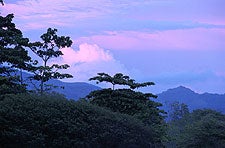 Pura vida: mountain forest in Costa Rica’s Guanacaste province
Pura vida: mountain forest in Costa Rica’s Guanacaste provinceQ: My friend and I are planning a trip to Costa Rica around January 2002. Is this a good time? Also, is it safe to hike and camp there?
— Joe-Anne Brantford, Ontario
���ϳԹ��� Advisor:
A: January is smack-dab in the middle of Costa Rica’s dry season, when the millions of exotic critters that put this country on the ecotourism map find themselves sharing fewer watering holes than usual—which means your chances of spotting a pond-side peccary are relatively good. Another plus: trails that are impassably sludgy in wetter times will be dry and hiker-friendly, especially if you keep to parks in the northern highlands and the Pacific northwest.
At its absolute best that time of year is Palo Verde National Park in the northwest province of Guanacaste. Hundreds of species of migratory birds stop here for the winter, joining in with the year-round residents to fill the park with chirps, squawks, and flurries of color (don’t even consider going to Costa Rica without binoculars). The 8,000-acre park includes a wide variety of habitats and is home to monkeys, deer, coatis (dog-sized rodents), and iguanas. Two well-marked hiking trails lead into the forest from the administration building. The shorter of the two (3.7 miles) takes you along the Rio Tempisque for views of the aptly-named Isla de los Pajaros (Bird Island). Though the island is off-limits to hikers, you can get pretty close to it by boat. Camping is available near park headquarters for $2 a night.
A word on safety: Though a few robberies have been reported on Costa Rican trails near San Jose and Jaco, hiking and camping in most of the country is considered much safer than, say, walking backing to your hostal in the capitol late at night. Unlike some other parts of Central America, parks here are not havens for criminals. The greatest potential danger to park visitors is getting stuck on a trail with too little water. So, fill up your bottle, send your itinerary to a friend, and leave your worries behind.


